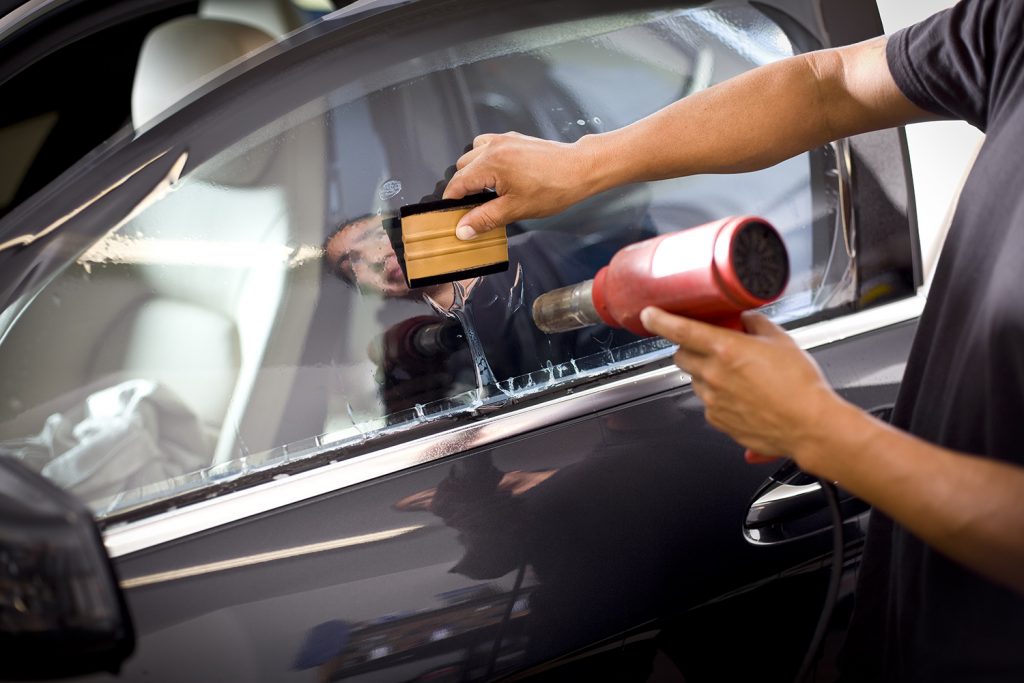The Very Best Window Tinting Choices for UV Defense and Warmth Decrease
The Very Best Window Tinting Choices for UV Defense and Warmth Decrease
Blog Article
The Process of Expert Home Window Tinting Explained
From picking the right film kind to the careful preparation of home windows, each action plays a critical role in accomplishing a remarkable application. Complying with these initial preparations, the mindful cutting and application of the film demand accuracy to stay clear of flaws.
Choosing the Right Window Film
Picking the right home window film includes comprehending numerous factors that influence both visual appeal and functionality. The preliminary consideration is the kind of movie, which can vary from dyed, metalized, to ceramic films. Dyed films mostly give privacy and aesthetic enhancement, while metalized movies mirror warmth and UV rays, improving energy effectiveness. Ceramic movies, although generally a lot more costly, offer premium performance without jeopardizing exposure.
Next, consider the movie's Visible Light Transmission (VLT) percent, which determines how much light enters the space. A lower VLT provides greater privacy and heat rejection but might lower all-natural light considerably. Furthermore, the film's solar heat gain coefficient (SHGC) is critical; a reduced SHGC shows much better thermal efficiency, assisting to keep indoor comfort.

Preparing the Windows
Once the ideal home window movie has been selected, the next action is extensively preparing the home windows for installation. This prep work is crucial for attaining optimum bond and ensuring a flawless appearance post-installation.
The first job involves cleansing the windows diligently (window tinting). A top notch glass cleaner is crucial, preferably one that is ammonia-free to stay clear of harmful any window seals or color materials. Making use of a lint-free cloth or paper towels, specialists must remove any kind of dirt, dust, or oil, paying special focus to the edges and edges where debris commonly gathers

Cutting the Movie
An exact approach to reducing the film is crucial for making sure a perfect fit on the ready windows. This step calls for both skill and focus to detail, as errors can result in undesirable spaces or overlaps that concession the aesthetic and practical qualities of the color.
Prior to cutting, the expert should determine the home window dimensions precisely, accounting for any kind of special forms or contours. It is a good idea to make use of premium home window movie, as this material often tends to be more forgiving throughout the reducing process. The film is commonly laid level on a tidy, smooth surface, and a sharp utility knife is used to make sure tidy edges.
To accomplish optimum outcomes, numerous experts make use of themes created from previous installations or utilize software to develop exact patterns. An usual strategy entails including an extra margin to the template, permitting modifications throughout the application stage.
Furthermore, cutting the film in a controlled atmosphere lessens the threat of contaminants affecting the adhesive side. By adhering to these careful techniques, home window tinting specialists can ensure that the film not just fits effortlessly yet official statement additionally executes properly with time, boosting both appearance and functionality.
Using the Color
After meticulously cutting the movie to the proper measurements, the next step involves using the color to the home window surface. This process begins with guaranteeing that the window is clean and without any type of dust, debris, or deposits that can impact attachment. A customized cleaning solution is typically utilized, webpage followed by thorough drying with a lint-free cloth.
Once the surface area is prepared, the installer will very carefully position the color film versus the glass. It is important to align the movie precisely to avoid misplacement, as any kind of errors can result in an unprofessional look. To facilitate this, the installer might utilize a light mist of application remedy on the sticky side of the movie, permitting slight rearranging if needed.
Using a squeegee, the installer will certainly then start to press the movie onto the glass, functioning from the center in an outward direction to eliminate air bubbles and make certain a firm bond. This strategy is critical, as it assures a smooth and perfect finish. Throughout the application, interest to detail is crucial to stop folds or imperfections, making certain that the color not just improves visual appeals yet also gives the desired functionality.
Last Assessment and Care
The last examination is a critical action in the home window tinting process, making sure that the installment meets both aesthetic and practical criteria. During this stage, specialists meticulously take a look at the mounted color for any flaws, such as bubbles, folds, or imbalances. An extensive analysis also includes checking the adherence of the film to the glass, along with its harmony and general appearance.
After the assessment, correct treatment and upkeep instructions are offered to the client. It is important to inform them about the recommended timeline for cleaning the tinted windows, commonly encouraging a wait of a minimum of 30 days after installation to enable the sticky to treat completely. Clients ought to be informed on suitable cleaning items and strategies, stressing the avoidance of ammonia-based cleansers that can harm the color.
Furthermore, experts ought to recommend customers on the importance of regular upkeep to visit this website lengthen the life of the tint. This consists of routine checks for signs of wear or damages and reacting immediately to any kind of concerns. By making sure a detailed final inspection and supplying clear treatment guidelines, home window tinting specialists improve client contentment and the longevity of their job.
Final Thought
The professional home window tinting process encompasses numerous critical actions that ensure high-grade results. Choosing the ideal film type, preparing the home windows thoroughly, precisely reducing the film, and using it with accuracy are vital for achieving a remarkable finish. A comprehensive last evaluation warranties that all requirements are fulfilled, while appropriate post-installation treatment is important for keeping the tint's durability and performance. Following these procedures eventually boosts both the aesthetic allure and functionality of the tinted windows.
Report this page